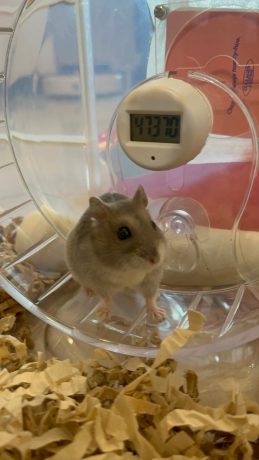When buying a hamster wheel, you should look at size, safety design, material, and noise level. If the wheel is too small, it can cause the hamster to arch its back unnaturally, leading to joint or spinal injuries. Also, check whether the design poses any risk of trapping your hamster, especially if they fall off the wheel at odd angles.
Related Read: Cage Size Requirements and Must-Have Accessories for Hamsters
Why Do Hamsters Need a Wheel?
In the wild, hamsters can run several kilometers a day. A wheel allows them to stay active in limited space, helping burn off energy, reduce stress, and prevent health issues.
Types of Hamster Wheels
Standalone Wheels
Pros: Easy to install, movable, and position-adjustable.
Cons: Takes up more space; must be stable to avoid tipping over.
Wall-Mounted Wheels
Pros: Saves space and offers better stability when attached to the cage wall.
Cons: Installation is more complex; needs to be securely fastened to prevent noise or movement.
Why You Should Avoid Flying Saucer Wheels
These horizontal wheels take up space and can cause hamsters to get flung off when they stop or change direction. They also promote unnatural spinal curvature, possibly causing long-term injury. Upright wheels are typically the safer option.




Flying Saucer Wheels
Recommended Wheel Sizes by Hamster Type
其實依照以下鼠種與建議的滾輪直徑選擇即可,買大了沒關係,但買小了會對健康造成危害。
| Size | Hamster Breed | Wheel Diameter |
| Large | Syrian Hamster | 10 in |
| Medium | Campbell’s, Winter White | 8 in |
| Small | Roborovski (Dwarf) | 7 in |
Safety Design Tips
- Choose wheels with support only on one side to avoid pinching or trapping.
- Avoid wheels with a high center of gravity that can tip over easily.
- Check for small holes, wire mesh, or bars that may hurt your hamster.
- Use your fingers to test the stability—see if the wheel shakes or tilts easily.
Material and Maintenance
Metal: Durable but heavier. Poor quality may be noisy; check for sharp edges.
Plastic: Lightweight and affordable. Less durable and may deform over time.
Wood: Quiet and aesthetically pleasing, but absorbs urine and needs frequent cleaning.
Clean the wheel weekly when you change the bedding.
Is It Really Silent?
Most “silent” wheels use ball bearings. But noise can still occur due to:
- Wheel hitting its support or cage wall.
- Loose structure causing vibration.
Before buying, push the wheel side to side to test for wobble or impact. Even DIY setups like IKEA storage boxes can generate noise if the wheel bumps the plastic walls.
How to Reduce Wheel Noise
- Ensure the wheel is firmly attached to its base or wall.
- Use rubber bands or padding to fill gaps and reduce vibration.
- Choose the right material: plastic for less noise, metal for durability, wood for style (but needs cleaning).
What If Your Hamster Doesn’t Use the Wheel?
- Place treats on the wheel to encourage exploration.
- Add hiding spots nearby to create a sense of safety.
- If the hamster still doesn’t use it, consult a vet to rule out health issues.
Recommended Silent Wheel
I’ve tested many so-called “silent” hamster wheels, and only one truly lived up to its name. Not only was the wheel itself quiet, but its solid structure meant it didn’t shake or shift during use. Best of all, it came with a digital lap counter so you can track how many laps your hamster runs each day!

